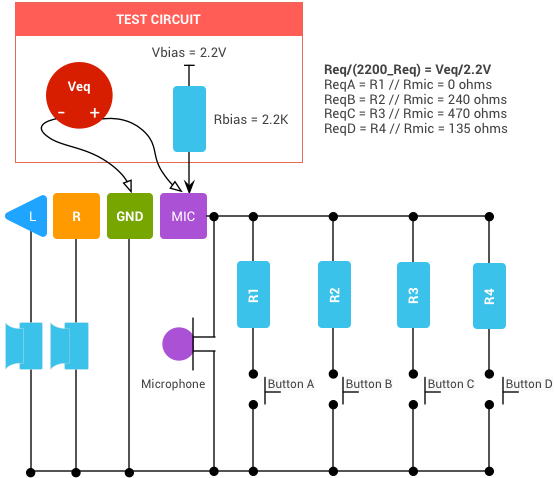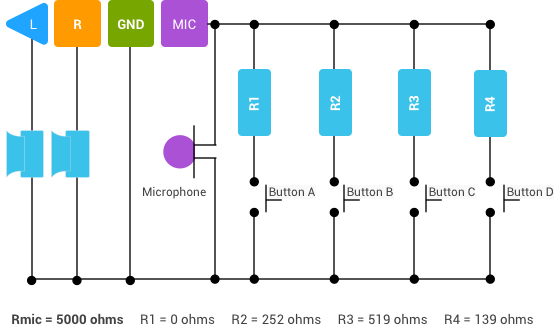本文介绍了有关使 3.5 毫米插头耳机在整个 Android 生态系统中实现一致功能的要求。
有关其他要求,设备制造商应参考 3.5 毫米耳机插孔规范和 Android 兼容性定义文档 (CDD)。
函数
| 函数 | 配件支持 |
|---|---|
| 立体声音频输出 | 必需 |
| 音频输入(麦克风) | 必需 |
| 接地 | 必需 |
控制功能映射
| 控制功能 | 配件支持 | 说明 |
|---|---|---|
| 功能 A | 必需 | 播放/暂停/接挂机(短按)、触发辅助(长按)、下一个(双击) |
| 功能 B | 可选 | 调高音量 |
| 功能 C | 可选 | Vol- |
| 功能 D | 可选 | 保留(Pixel 设备使用此功能来启动语音命令) |
按钮的功能分配如下:
- 所有单按钮耳机都必须实现功能 A。
- 多按钮耳机必须按照以下模式实现相关功能:
- 2 个功能:A 和 D
- 3 个功能:A、B、C
- 4 个功能:A、B、C、D
机械
| 函数 | 配件支持 | 备注 |
|---|---|---|
| 4 段式 3.5 毫米插头 | 必需 | 参考号:EIAJ-RC5325A 标准 |
| CTIA 引脚顺序 (LRGM) | 必需 | 对 OMTP 引脚有法律要求的区域除外 |
| OMTP 引脚顺序 (LRMG) | 可选 | |
| 麦克风 | 必需 | 在操作耳机控件时不能被遮挡 |
电气
| 函数 | 配件支持 | 说明 |
|---|---|---|
| 耳机扬声器阻抗 | 16 欧姆或更高 | 推荐 32 - 300 欧姆 |
| 麦克风直流电阻 | 1000 欧姆或更高 | 麦克风特性必须符合最新 Android CDD 中第 5.4 节“音频录制”的要求 |
| 控制功能等效阻抗* | 0 欧姆 | [功能 A] 播放/暂停/接挂机 |
| 240 欧姆 +/- 1% 电阻 | [功能 B] | |
| 470 欧姆 ± 1% 电阻 | [功能 C] | |
| 135 欧姆 +/- 1% 电阻 | [功能 D] |
*按下按钮(通过 2.2 千欧姆电阻施加 2.2 伏麦克风偏置电压)时从正极麦克风端子到 GND 的总阻抗
在下图中,按钮 A 对应功能 A,按钮 B 对应功能 B,依此类推。
参考耳机测试电路
下图“参考耳机测试电路 1”显示了 4 段式插头的 CTIA 引脚。对于 OMTP 引脚,交换 MIC 段和 GND 段的位置。

图 1. 参考耳机测试电路 1
下图“参考耳机测试电路 2”显示了如何更改实际电阻值 (R1 - R4) 以符合本规范。

图 2. 参考耳机测试电路 2
与麦克风平行的按钮的实际电阻 (R1 - R4) 基于麦克风套管电阻 (Rmic) 和等效阻抗值 (ReqA - ReqD)。使用以下公式:
ReqN=(Rmic*Rn)/(Rmic+Rn)
其中,Rn 是按钮的实际电阻,ReqN 是该按钮的等效阻抗值(已提供),Rmic 是麦克风阻抗值。
以上示例假设麦克风阻抗 (Rmic) 为 5 千欧姆;为达到 135 欧姆的等效 R4 阻抗 (ReqD),实际电阻值 (R4) 必须为 139 欧姆。
